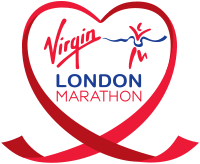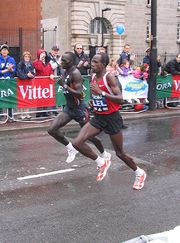London Marathon
| London Marathon | |
|---|---|
 Virgin London Marathon Logo |
|
| Date | April |
| Location | London, United Kingdom |
| Race type | Road |
| Distance | Marathon |
| Established | 1981 |
| Official site | www.london-marathon.co.uk 2009 www.virginlondonmarathon.com/ 2010 |
The London Marathon is a charity road marathon that has been held each spring in London since 1981. The race is currently sponsored by Virgin Money, as the Virgin London Marathon. Previously the event was sponsored by Flora (from 1996 to 2009). The 2010 London Marathon, the thirtieth race, took place on Sunday, 25 April 2010.
In addition to being one of the top five international marathons run over the traditional distance of 42.195 km (26 miles and 385 yards), the London Marathon is also a large, celebratory sporting festival, second only to the Great North Run in Newcastle, in terms of the number of participants. It is one of the World Marathon Majors, a two-year series of elite marathon racing that also includes the Boston, Chicago, New York and Berlin marathons.
An unusual feature is the very large amounts of money raised for charity, much more than other marathons.[1] According to the race organisers, it is now the largest annual fund raising event in the world with the 2006 participants raising over £41.5 million for charity, bringing the total amount raised for charity by runners, to a grand total of £315 million.[2] In 2007, 78% of all runners raised money. In 2011 the official charity of the London Marathon is Oxfam [3].
The company behind the London Marathon has been the subject of an investigation by the Channel 4 Dispatches programme for not publishing a full breakdown of its accounts and in relation the amount of money charged to some charities in order to take part.[4]
Contents |
History

The London Marathon was founded by the former Olympic champion and renowned journalist Chris Brasher and Welsh athlete John Disley.[5] In November 1979, shortly after completing the New York Marathon, Brasher wrote an article for The Observer newspaper which began:
"To believe this story you must believe that the human race be one joyous family, working together, laughing together, achieving the impossible. Last Sunday, in one of the most trouble-stricken cities in the world, 11,532 men and women from 40 countries in the world, assisted by over a million black, white and yellow people, laughed, cheered and suffered during the greatest folk festival the world has seen."
Inspired by the people of New York coming together for this occasion, he went on to question;
"...whether London could stage such a festival?"[6]
In 1980, Brasher and Disley made trips to America to study the organisation and finance of big city marathons such as the New York and Boston Marathons. Brasher signed a contract with Gillette for £50,000, established charitable status and outlined six main aims in the hope to mirror the scenes he witnessed in New York and establish the United Kingdom on the map as a country capable of arranging major events. The London Marathon was born.[7]
The first London Marathon was held on 29 March 1981, more than 20,000 applied to run. 6,747 were accepted and 6,255 crossed the finish line on Constitution Hill. The Marathon's popularity has steadily grown since then. As at 2009, 746,635 people have completed the race since its inception[8]. In 2010, 36,549 people crossed the line, the biggest field since the race began[9].
The first wheelchair marathon race was held in 1983 and the event was credited with reducing the stigma surrounding disabled athletes.[10]
The race is currently organised by former 10,000m world record holder David Bedford as Race Director and Nick Bitel as Chief Executive. Bedford and Bitel have overseen a period of great change for the race, including amendments to the course in 2005 which saw the famous cobbled section by the Tower of London replaced with a flat stretch along the Highway.[11]
Whilst it is a serious athletic event, with large prize money attracting elite athletes, public perception of the race is dominated by club and fun runners. Only the summer British 10K race closes the centre of London similarly to the marathon. Sometimes in ludicrous fancy dress and often collecting money for charity, these make up the bulk of the 30,000+ runners and help to draw crowds of half a million on the streets. Nine people have died in relation to running the London Marathon since the event began, with the most recent being a 22-year-old man[12] who died of hyponatremia in 2007.[13]
In 2002, Lloyd Scott completed the marathon wearing a deep sea diving suit that weighed a total of 110 lb and each shoe weighed 11 kg, he also set a world record for the slowest ever marathon time.
On 19 April 2003, former boxer Michael Watson, who had been told he would never be able to walk again after a fight with Chris Eubank, made headlines by finishing the marathon in six days, becoming a national hero in England.
In 2006, Sir Steve Redgrave (winner of five consecutive Olympic gold medals) set a new Guinness World Record for money raised through a marathon by collecting £1.8 million in sponsorship. This broke the record set the previous year by the founder of the Oasis Trust, Steve Chalke MBE, who had collected over £1.25 million. Steve Chalke recovered the record in 2007, raising at least £1.85 million.[14]
A small number of runners, known as the "Ever Presents", have completed each of the London Marathons since 1981. By 2010 their number had shrunk to 20. As of 2010, the oldest runners amongst them are 75 year old Kenneth Jones and Jeffrey Gordon, whilst the youngest runner is 50-year-old ultra-runner and father of 3 Chris Finill. They are all male.[15]
Course description and information

Set over a largely flat course around the River Thames, the London Marathon is generally regarded as a very competitive and unpredictable event, and conducive to fast times. Spanning 42.195 kilometres (26 miles and 385 yards),[16] it is the only Marathon course in the world that is run in two hemispheres, both the East and West, as the full course crosses the Prime Meridian in Greenwich.
The course begins at three separate points around Blackheath at 35 m (115 ft) above sea level, on the south of the River Thames, and heads east through Charlton. The three courses converge after 4.8 km (3 miles) in Woolwich, where the Royal Artillery Barracks is passed.[17][18]
As the runners reach the 6-mile (9.6 km) mark, they pass by the Old Royal Naval College and head towards Cutty Sark drydocked in Greenwich. Heading next into Surrey Quays in the Docklands, and out towards Bermondsey, competitors race along Jamaica Road before reaching the half-way point as they cross the Tower Bridge. Running east again along The Highway through Wapping, competitors head up towards Limehouse and into Mudchute in the Isle of Dogs via Westferry Road, before heading into Canary Wharf.[17][18]
As the route leads away from Canary Wharf into Poplar, competitors run west down Poplar High Street back towards Limehouse and on through Commercial Road. They then move back onto The Highway, onto Lower and Upper Thames Streets.. Heading into the final leg of the race, competitors pass St Paul's Cathedral on Ludgate Hill. In the penultimate mile along The Embankment, the London Eye comes into view, before the athletes turn right into Birdcage Walk to complete the final 352 m (385 yards), catching the sights of Big Ben and Buckingham Palace, and finishing in The Mall alongside St. James's Palace.[17][18] This final section of the route will form part of the 2012 Olympic Marathon Course.
Since the first marathon, the course has undergone very few route changes. In 1982, the finishing post was moved from Constitution Hill to Westminster Bridge due to construction works. It remained there for twelve years before moving to its present location at The Mall. In 2005, the route around the Isle of Dogs between 22 (14) and 34 km (21 miles) was switched from a clockwise to an anti-clockwise direction, and at 35 km (22 miles) the route was diverted to avoid the cobblestoned area near the Tower of London. In 2008, a suspected gas leak at a pub in Wapping diverted the course, but in 2009 the race followed the same path as in 2007.[19][20]
During the 2001 Foot-and-Mouth crisis which closed access to much of England's countryside, the London Marathon route emerged as one of the most popular urban rambling routes.
Mini Marathon
The Adidas Mini Marathon is the sister of The London Marathon. The course is the last three miles of the London Marathon and is aimed at ages 11–17 from all 33 London Boroughs along with 13 teams from ten English counties and three Home Countries: Scotland, Wales and Northern Ireland. There is also a Mini Wheelchair race on the day.
Medical cover
Medical cover is provided mainly by the volunteers of St. John Ambulance. Its members travel from all over the country to care for runners who require medical attention. Assistance is also provided by podiatry students from the University of Northampton and the University of Brighton.
Television coverage
The BBC covers the event, devoting rolling coverage for most of the morning. The theme music associated with this coverage, and with the event itself, is called Main Titles to The Trap, composed by Ron Goodwin for the film The Trap.
2010 Sponsorship
On 16 May 2008, London Marathon Limited signed a new five year sponsorship deal with Virgin and Virgin Money. Virgin will spend £17m on the five year deal.
Sponsors and Partners

- Gillette (Official Sponsor 1981-1983)
- Mars (Official Sponsor 1984-1988)
- ADT (Official Sponsor 1989-1992)
- NutraSweet (Official Sponsor 1993-1995)
- Flora (Official Sponsor 1996-2009)
- Virgin (Official Sponsor 2010 - 2014)
- Adidas
- Lucozade Sport
- Vittel
- Holiday Inn
- London Pride
- Renault
- Runner's World
- Timex
- TNT
- The Children's Trust, Tadworth
- BBC Sport
- BBC London
- BBC Radio 5 Live
- realbuzz.com
See also
- List of winners of the London Marathon
- Running
- Half marathon
- Exercise
- London Triathlon
References
- ↑ The London Marathon | Give it everything you've got | Economist.com
- ↑ "Flora London Marathon website: Press Releases". http://www.london-marathon.co.uk/site/media_centre/index.php?page=60. Retrieved 2007-02-01.
- ↑ http://www.virginlondonmarathon.com/marathon-centre/2011-virgin-london-marathon-information/official-virgin-london-marathon-sponsors/
- ↑ http://www.channel4.com/programmes/dispatches/articles/tracing-the-marathons-millions-producer-feature
- ↑ http://www.virginlondonmarathon.com/marathon-centre/history-london-marathon/in-the-beginning/
- ↑ "Virgin London Marathon - Background". http://www.virginlondonmarathon.com/marathon-centre/history-london-marathon/in-the-beginning/. Retrieved 2009-04-29.
- ↑ "Flora London Marathon - Background". http://www.london-marathon.co.uk/site/?pageID=2&submenu=12&article=1. Retrieved 2008-11-06.
- ↑ "Virgin London Marathon - Background". http://www.virginlondonmarathon.com/marathon-centre/history-london-marathon/in-the-beginning/. Retrieved 2009-04-29.
- ↑ "Record Numbers Finish Virgin London Marathon". http://lrn.london-marathon.com/record-numbers-finish-first-virgin-london-marathon/. Retrieved 2010-04-30.
- ↑ London Marathon. Museum of London. Retrieved on 2009-04-29.
- ↑ "Flora London Marathon website: Marathon History: Course History". http://www.london-marathon.co.uk/site/marathon_history/index.php?page=2. Retrieved 2007-02-01.
- ↑ "BBC News Website Article: Runner dies after London Marathon". 23 April 2007. http://news.bbc.co.uk/1/hi/england/london/6583677.stm. Retrieved 2007-04-24.
- ↑ MK News
- ↑ Oasis Trust
- ↑ Ever Present Home Page
- ↑ The 2009 London Marathon Highlights. Steve Cram (presenter). British Broadcasting Corporation. BBC Two. 26 April 2009.
- ↑ 17.0 17.1 17.2 "Interactive Marathon Map". BBC News. 23 April 2009. http://news.bbc.co.uk/sport2/hi/athletics/8011891.stm. Retrieved 13 May 2009.
- ↑ 18.0 18.1 18.2 Storey, Peter; Onanuga, Tola; Murphy, Sam; Ashdown, John (23 April 2009). "London Marathon 2009: Mile-by-mile route map". The Guardian. http://www.guardian.co.uk/lifeandstyle/interactive/2009/apr/22/london-marathon-route-map. Retrieved 13 May 2009.
- ↑ Gliddon, Abigail; Onanuga, Tola (24 April 2009). "London Marathon: A brief history". The Guardian. http://www.guardian.co.uk/lifeandstyle/2009/apr/24/london-marathon-brief-history. Retrieved 13 May 2009.
- ↑ "History of the London Marathon – Course History". London Marathon. http://www.virginlondonmarathon.com/marathon-centre/history-london-marathon/course-history/. Retrieved 13 May 2009.
External links
- Official website
- Official London Marathon Blogs at realbuzz.com
- Official London Marathon Forums at realbuzz.com
- Virgin London Marathon website
- Adidas Mini London Marathon
- London Marathon 2010 Information
- London Marathon Route Guide
- Interactive Route map from the Guardian (2009 route)
- Historical weather information for marathon days in London
|
|||||
|
|||||||
|
||||||||||||||||||||||||||||||
